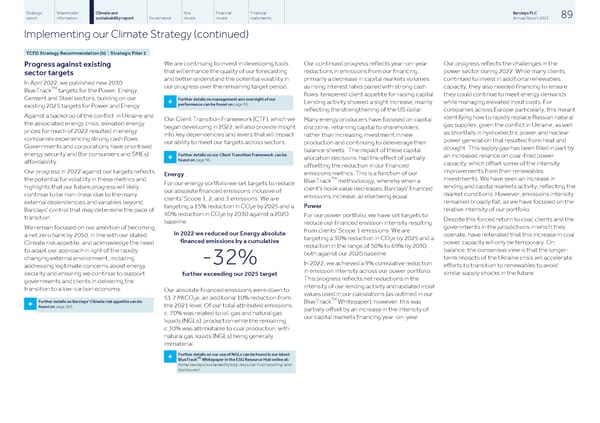Strategic Shareholder Climate and Risk Financial Financial Barclays PLC 89 report information sustainability report Governance review review statements Annual Report 2022 Implementing our Climate Strategy (continued) TCFD Strategy Recommendation (b) | Strategic Pillar 2 We are continuing to invest in developing tools Our continued progress reflects year-on-year Our progress reflects the challenges in the Progress against existing that will enhance the quality of our forecasting reductions in emissions from our financing, power sector during 2022. While many clients sector targets and better understand the potential volatility in primarily a decrease in capital markets volumes continued to invest in additional renewables In April 2022, we published new 2030 our progress over the remaining target period. as rising interest rates paired with strong cash capacity, they also needed financing to ensure TM BlueTrack targets for the Power, Energy, flows tempered client appetite for raising capital. they could continue to meet energy demands Cement and Steel sectors, building on our Further details on management and oversight of our Lending activity showed a slight increase, mainly while managing elevated input costs. For + performance can be found on page 95. existing 2025 targets for Power and Energy. reflecting the strengthening of the US dollar. companies across Europe particularly, this meant Against a backdrop of the conflict in Ukraine and identifying how to rapidly replace Russian natural Our Client Transition Framework (CTF), which we Many energy producers have focused on capital the associated energy crisis, elevated energy gas supplies, given the conflict in Ukraine, as well began developing in 2022, will also provide insight discipline, returning capital to shareholders, prices for much of 2022 resulted in energy as shortfalls in hydroelectric power and nuclear into key dependencies and levers that will impact rather than increasing investment in new companies experiencing strong cash flows. power generation that resulted from heat and our ability to meet our targets across sectors. production and continuing to deleverage their Governments and corporations have prioritised drought. This supply gap has been filled in part by balance sheets. The impact of these capital energy security and (for consumers and SMEs) Further details on our Client Transition Framework can be an increased reliance on coal-fired power allocation decisions had the effect of partially + found on page 96. affordability. capacity, which offset some of the intensity offsetting the reduction in our financed improvements from their renewables Our progress in 2022 against our targets reflects emissions metrics. This is a function of our Energy TM investments. We have seen an increase in the potential for volatility in these metrics and BlueTrack methodology, whereby when a For our energy portfolio we set targets to reduce lending and capital markets activity, reflecting the highlights that our future progress will likely client's book value decreases, Barclays' financed our absolute financed emissions inclusive of market conditions. However, emissions intensity continue to be non-linear due to the many emissions increase, all else being equal. clients' Scope 1, 2, and 3 emissions. We are remained broadly flat, as we have focused on the external dependencies and variables beyond Power targeting a 15% reduction in CO e by 2025 and a 2 relative intensity of our portfolio. Barclays' control that may determine the pace of 40% reduction in CO e by 2030 against a 2020 For our power portfolio, we have set targets to 2 transition. Despite this forced return to coal, clients and the baseline. reduce our financed emission intensity resulting governments in the jurisdictions in which they We remain focused on our ambition of becoming from clients’ Scope 1 emissions. We are In 2022 we reduced our Energy absolute operate, have reiterated that this increase in coal a net zero bank by 2050, in line with our stated targeting a 30% reduction in CO e by 2025 and a 2 financed emissions by a cumulative power capacity will only be temporary. On Climate risk appetite, and acknowledge the need reduction in the range of 50% to 69% by 2030, balance, the consensus view is that the longer- to adapt our approach in light of the rapidly both against our 2020 baseline. term impacts of the Ukraine crisis will accelerate changing external environment, including -32% In 2022, we achieved a 9% cumulative reduction efforts to transition to renewables to avoid addressing legitimate concerns about energy in emission intensity across our power portfolio. similar supply shocks in the future. security and ensuring we continue to support further exceeding our 2025 target This progress reflects net reductions in the governments and clients in delivering the intensity of our lending activity and updated input transition to a low-carbon economy. Our absolute financed emissions were down to values used in our calculations (as outlined in our 51.7 MtCO e, an additional 10% reduction from TM 2 Further details on Barclays' Climate risk appetite can be BlueTrack Whitepaper), however, this was + the 2021 level. Of our total attributed emissions, found on page 283. partially offset by an increase in the intensity of c. 70% was related to oil, gas and natural gas our capital markets financing year-on-year. liquids (NGLs) production while the remaining c.30% was attributable to coal production, with natural gas liquids (NGLs) being generally immaterial. Further details on our use of NGLs can be found in our latest TM + BlueTrack Whitepaper in the ESG Resource Hub online at: home.barclays/sustainability/esg-resource-hub/reporting-and- disclosures/
 Barclays PLC - Annual Report - 2022 Page 90 Page 92
Barclays PLC - Annual Report - 2022 Page 90 Page 92